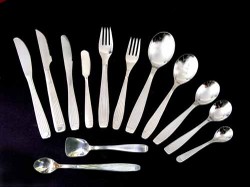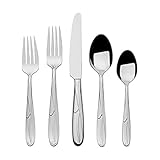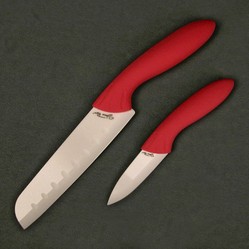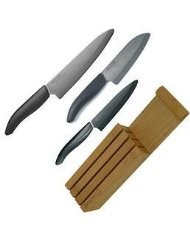When I first started out having my own apartment as a teenager, I picked out my first stainless cutlery set, and wouldn't you know, I still have it and use it! However, I have discovered that although my flatware has held up for more than forty years, I could have made a better choice in the beginning, and probably ended up buying one less set than I currently have. While I paid very little for that first set, spending a few dollars more probably would have saved me money in the long run.

How to Choose a Stainless Flatware Set
It takes more than a beautiful pattern to make a great set of stainless flatware!
What's all the Fuss?
A Fork isn't Just a Fork!
Let's face it, we all use cutlery for more than just eating: scraping dishes; cutting up something if all our other kitchen knives are dirty; prying off lids; and many more uses. That flatware is handy and usually right within reach, where our specialized kitchen tools may be farther away. While I encourage everyone to use the proper tool for the proper job, there's no getting around human laziness!
However, most of us pick our sets on design alone, and forget about how the utensils in the set will be used in real life. So the next time you are ready to choose a cutlery set, it's best to keep certain factors in mind.
I bought my stainless flatware based on:
What to Look For:
- Alloy: Stainless sets should be marked 18/8 or 18/10. These numbers refer to the amount of chromium and nickel allowed in the alloy. Anything less than this (especially 18/0) and the flatware will not hold up to everyday use. Note: if you are allergic to nickel, you may want to consider 18/0 and hope to make up for it with the other factors in the list.
- Sturdiness: Your tableware should not bend, even when considerable pressure is put on it. In particular, test the tines of forks, handles of spoons, and the ends of the knife blades. If any of these show bends, choose a different set. Otherwise, you will be very upset when you are digging out a scoop of hard ice cream, and your spoon handle bends.
- Edges: Knives should have working serrations. Preferably, tines of forks should be straight, rather than curve inward.
- Depth: Forks and spoons should have enough depth to pile up food. Spoons should have a sharp enough end to get into the edges of mugs.
- Ends: Knives should have rounded ends on the blades, both to prevent eaters from injuring themselves, and for better scraping ability. (We all know someone who licks the knife, after all!)
- Construction: Molded or injection flatware is better than stamped.
- Balance and heft: The cutlery should feel good in your hands, and not awkward to use.
- Finish: Matte holds up better than shiny.
- Warranty: A good flatware set should last you a lifetime, or close to it. Look for better than a ten-year warranty, and file that receipt safely away in your filing cabinet!
 | Mikasa Cocoa Blossom 18/10 65-Piece Flatware Set Enjoy the classic look of 18/10 stainless steel flatware. 65-piece service includes 12 five-piece place settings and a hostess set consisting of two serving spoons (one pierced)... |
While one cannot expect perfection in anything, this set may come closest. The knives are not sufficiently serrated, in my opinion, but everything else about this beautiful set deserves consideration, especially the resistance to bending. It even comes with a 25-year warranty!
Now that you are an informed consumer, I hope you will make your next cutlery purchase wisely, and enjoy it for many years to come!
You might also like
Smart Care Advice for Ceramic KnivesLearn about how to care for your ceramic knives, and why special care is nece...
Kitchen Knives That Never Need SharpeningTired of constantly sharpening dull kitchen knives? Is there such a thing as ...



 My Experience with KaiZenon 04/19/2016
My Experience with KaiZenon 04/19/2016
 How to Use Your Car Cigarette Lighter: Fun, Ridiculous and Useful Aftermarket 12-volt Accessorieson 10/03/2015
How to Use Your Car Cigarette Lighter: Fun, Ridiculous and Useful Aftermarket 12-volt Accessorieson 10/03/2015
 Why Use NextDoor?on 07/13/2015
Why Use NextDoor?on 07/13/2015
 Food Network Toaster Reviewon 06/12/2015
Food Network Toaster Reviewon 06/12/2015



Comments